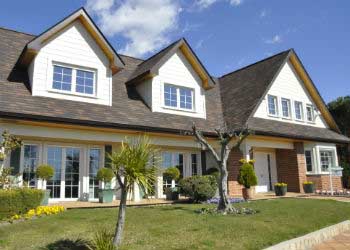What is a 'passivhaus' or passive house?
The 'passivhaus' have become a revolution thanks to the many economic and health benefits they provide to their usersReaching the correct temperature and manage the energy consumption can sometimes be hard for the families. In many of our homes we waste energy in small actions difficult to perceive, but there are buildings that improve energy efficiency and reduce energy consumption without compromising our basic needs. This is the case of passive houses or passivhaus.

'Passivhaus': what is it?
It is a type of housing designed to maintain the ideal atmospheric conditions inside achieving between 70% and 90% energy savings compared to a conventional house. This buildings must have an optimum thermal insulation on its exterior walls, thermal break -which avoids the inner and outer side of a window to touch each other to eliminate the loss of warmth-, mechanical ventilation with heat recovery and high performance windows and doors.
Although it is now when passive houses are gaining prominence, the fact is that the origin of the concept of passive house goes nearly three decades back. In 1988 teachers Bo Adamson, from Lund University in Sweden, and Wolfgang Feist, from the Institute for Housing and the Environment of Germany, came up with this type of structure and coined the term passivhaus ("passive house" in German). Today, this word is also used to name the standardization system -issued by the German Passivhaus Institut- under which all passive buildings in the world have to meet certain requirements to be classified as such.
Health benefits
Passivhaus or passive houses are also a great example of sustainability. They are not good only in economic terms but also in social and environmental. Numerous studies support the suitability for the health of the inhabitants of these houses thanks to its intelligent air exchange, the incidence of sunlight and its construction with natural and less polluting materials than conventional buildings help prevent and reduce diseases and respiratory tract infections such as fibromyalgia or asthma, among others.
and its construction with natural and less polluting materials than conventional buildings help prevent and reduce diseases and respiratory tract infections such as fibromyalgia or asthma, among others.
'Passivhaus': what applications does it have?
The progress made so far in the development of passive houses or passivhaus have focused on single family homes. However, its usefulness is much greater, because this type of construction is applicable in hotels, offices, government buildings, schools ...
For example, two projects of high passivhaus buildings have already started in New York and Bilbao, which will have 83 and 88 meters, respectively, and when its construction is complete by 2017 they will be the highest in the world, for the moment.
What is your opinion about the passivhaus? Tell us and participate in our poll.
Sources: El Mundo, Plataforma de Edificiación Passivhaus, Passivhaus Institut, El Mundo II, 20 Minutos, Energiehaus, Passivhaus UK and Ecohouses.





